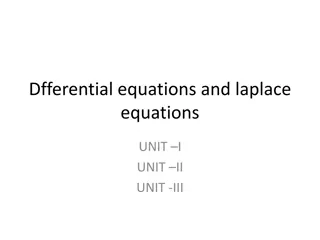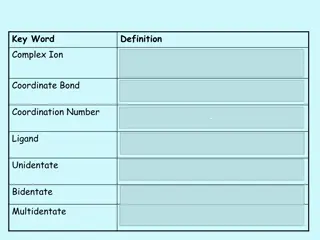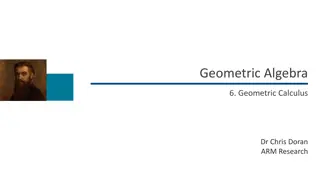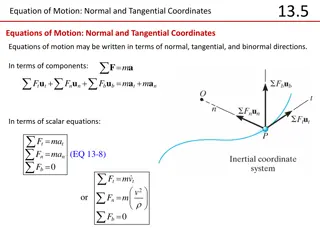Coordinate System and Equations for College Algebra
This content covers the Cartesian coordinate system, distance formula, midpoint formula, graphing linear equations, and finding intercepts. It provides explanations, formulas, interactive resources, and practical tips for understanding and applying these concepts in College Algebra.
Download Presentation

Please find below an Image/Link to download the presentation.
The content on the website is provided AS IS for your information and personal use only. It may not be sold, licensed, or shared on other websites without obtaining consent from the author.If you encounter any issues during the download, it is possible that the publisher has removed the file from their server.
You are allowed to download the files provided on this website for personal or commercial use, subject to the condition that they are used lawfully. All files are the property of their respective owners.
The content on the website is provided AS IS for your information and personal use only. It may not be sold, licensed, or shared on other websites without obtaining consent from the author.
E N D
Presentation Transcript
The Rectangular Coordinate System and Equations of Lines College Algebra
Cartesian Coordinate System A grid system based on a two-dimensional plane with perpendicular axes: horizontal axis is the x-axis vertical axis is the y-axis The axes intersect at the origin and divide the plane into four quadrants A point in the plane is defined as an ordered pair, (?,?), such that ? is determined by its horizontal distance from the origin and ? is determined by its vertical distance from the origin.
The Distance Formula Derived from the Pythagorean Theorem, the distance formula is used to find the distance between two points in the plane. Given endpoints (?1,?1) and (?2,?2), the distance between them is given by: (?2 ?1)2+ ?2 ?1 2 ? =
Desmos Interactive Topic: distance in the plane https://www.desmos.com/calculator/nrtjcgmy69
The Midpoint Formula When endpoints of a line segment are known, we can find the point midway between them. This point is known as the midpoint and the formula is the midpoint formula Given the endpoints of a line segment, (?1,?1) and (?2,?2), the midpoint formula states how to find the coordinates of the midpoint ? ?1+ ?2 2 ,?1+ ?2 2 ? =
Desmos Interactive Topic: midpoints and the center of a circle https://www.desmos.com/calculator/j2blmpiid7
Graphing a Linear Equation by Plotting Points 1. Make a table with one column labeled ?, a second column labeled with the equation, and a third column listing the resulting ordered pairs 2. Enter ?-values down the first column using positive and negative values (selecting the ?-values in numerical order will make graphing simpler) 3. Select ?-values that will yield y-values with little effort 4. Plot the ordered pairs 5. Connect the points if they form a line
Find the Intercepts for an Equation 1. Find the ?-intercept by setting ? = 0 and solving for ? 2. Find the ?-intercept by setting ? = 0 and solving for ? Example: Find the intercepts of the equation ? = 3? 4 Solution: Set ? = 0 to find the ?-intercept. 0 = 3? 4; ? = 4 3 Set ? = 0 to find the ?-intercept. ? = 3 0 4; ? = 4 The ?-intercept is at ( 4 3,0) and the ?-intercept is at (0, 4)
The Slope of a Line The slope of a line, ?, represents the change in ? over the change in ?. Given two points, (?1,?1) and (?2,?2), the following formula determines the slope of a line containing these points: ? =(?2 ?1) (?2 ?1)
The Point-Slope Formula Given one point and the slope, the point-slope formula will lead to the equation of a line: ? ?1= ?(? ?1) Example: Write the equation of the line with slope ? = 3 and passing through the point (4,8) Solution: ? 8 = 3 ? 4 ? = 3? + 20
Standard Form of Line Another way to represent the equation of a line is in standard form: ?? + ?? = ? where ?, ?, and ? are integers Example: Find the standard form of the line with ? = 6 and passing through the point 4,2 Solution: Start with the point-slope formula and rearrange terms. ? 2 = 6 ? 1 1 4 ? + 2 = 6? +3 2? + 4 = 12? + 3 12? + 2? = 1 2
Vertical and Horizontal Lines The equation of a vertical line is given as: ? = ?, where ? is a constant The slope of a vertical line is undefined, and regardless of the ?-value of any point on the line, the ?-coordinate of the point will be ?. The equation of a horizontal line is similarly given as: ? = ? The slope of a horizontal line is zero, and for any ?-value of a point on the line, the ?-coordinate of the point will be ?.
Parallel and Perpendicular Lines Parallel lines have the same slope and different y-intercepts. Lines that are parallel to each other will never intersect. Lines that are perpendicular intersect to form a 90 angle. The slope of one line is the negative reciprocal of the other.
Writing Equations of Parallel Lines Given the equation of a function and a point through which its graph passes, write the equation of a line parallel to the given line that passes through the given point 1. Find the slope of the function 2. Substitute the given values into either the general point-slope equation or the slope-intercept equation for a line 3. Simplify
Writing Equations of Perpendicular Lines Given the equation of a function and a point through which its graph passes, write the equation of a line perpendicular to the given line 1. Find the slope of the function 2. Determine the negative reciprocal of the slope 3. Substitute the new slope and the values for ? and ? from the coordinate pair provided into ? ? = ?? + ? 4. Solve for ? 5. Write the equation for the line
Writing Equations of Perpendicular Lines Given two points on a line and a third point, write the equation of the perpendicular line that passes through the point 1. Determine the slope of the line passing through the points 2. Find the negative reciprocal of the slope 3. Use the slope-intercept form or point-slope form to write the equation by substituting the known values 4. Simplify
Writing Equations of Perpendicular Lines Given an equation for a line, write the equation of a line parallel or perpendicular to it 1. Find the slope of the given line. The easiest way to do this is to write the equation in slope-intercept form 2. Use the slope and the given point with the point-slope formula 3. Simplify the line to slope-intercept form and compare the equation to the given line
Models and Applications of Linear Equations To set up or model a linear equation to fit a real-world application, we must first determine the known quantities and define the unknown quantity as a variable. Then, we begin to interpret the words as mathematical expressions using mathematical symbols. Example: Consider a car rental agency that charges $0.10/mi plus a daily fee of $50. We can use these quantities to model an equation that can be used to find the daily car rental cost ?. ? = 0.10? + 50
Translate Verbal Expressions to Math Operations Verbal Expression Translation to Math Operations One number exceeds another by ? Twice a number One number is a more than another number One number is a less than twice another number The product of a number and ?, decreased by ? The quotient of a number and the number plus ? is three times the number The product of three times a number and the number decreased by ? is ? ?,? + ? 2? ?,? + ? ?,2? ? ?? ? ? ? + 3= 3? 3? ? ? = ?
Develop a Problem-Solving Method Given a real-world problem, model a linear equation to fit it 1. Identify known quantities 2. Assign a variable to represent the unknown quantity 3. If there is more than one unknown quantity, find a way to write the second unknown in terms of the first 4. Write an equation interpreting the words as mathematical operations 5. Solve the equation. Be sure the solution can be explained in words, including the units of measure
Quick Review How is a point defined in the Cartesian coordinate system? How do you compute the distance between two points in a plane? What is the midpoint formula? How do you graph a linear equation by plotting points? How do you find the ? and ?-intercepts of a linear equation? What is the slope-intercept form for the equation of a line? What is the standard form for the equation of a line? What are the general equations for horizontal and vertical lines? How do you determine whether two lines are parallel, perpendicular, or neither? How do you write an equation for a line that is parallel or perpendicular to another line? What are the steps to model an application with linear equations?























